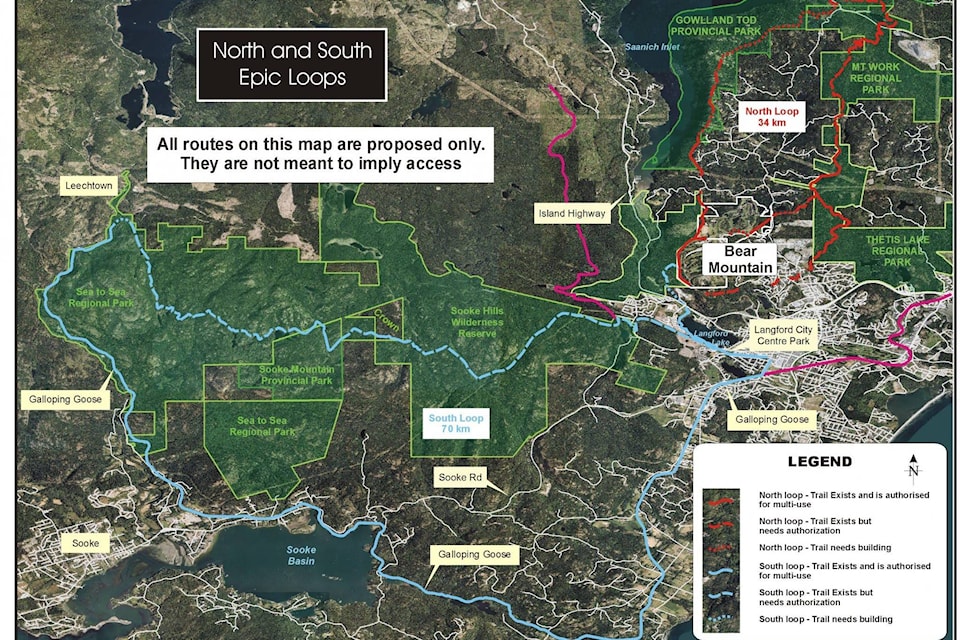Imagine a two-hour bike ride on easy trails through the woods of the Saanich Peninsula that takes you back to where you started, all without the worry of cars passing you.
That’s the vision of the Nature Trail Society, a four-year-old group of Victoria-based volunteers who are in the process of linking offroad trails throughout the Capital Regional District. The trails network would take users on long-distance loops through the woods of Langford and Sooke, or through the Highlands and Saanich, all without using roads.
READ ALSO: Victoria’s off-road cycling event brings on the mud and mess
Since 2017 the society has partnered with other groups to build about seven different trails. An example of how it could look is the annual Tripleshot Cycling Club’s Crossfondo, which uses a slew of one-day permits to create a 40-kilometre and 25-kilometre course through Saanich and the Highlands. The two courses are otherwise off-limits the rest of the year as BC Hydro, Camosun College, and many private property owners all make pieces of their land available for the one day (many property owners sip coffee and cheer as the participants spin through their backyards).
The event is billed as both a mass-participation event but also has a competitive field. It’s actually a fundraiser that has donated thousands of dollars to the Nature Trail Society and the South Island Mountain Bike Society. Most of the CrossFondo trail accesses will never be made permanent, as some go through deck porches and greenhouses, but the point is to support the NTS to create year-round options for off-road routes, said Lister Farrar of Tripleshot Cycling.
| Local cyclist David Dallin cuts through the frame of an old truck during the 2019 Tripleshot CrossFondo, a one-day event that uses private property to create 40-kilometre course through Saanich and the Highlands. A local advocacy group, the Nature Trails Society, hopes to create a permanent network of offroad trails throughout the Greater Victoria region. |
Now, with the province urging residents to accept social distancing as a cultural norm for the foreseeable future, access to nature is seen as a solution for emotional health, promoted by none other than Dr. Bonnie Henry.
“Coming out of this pandemic we’ll find these trails are becoming even more important,” said Nature Trails president Kim Nemrava. “They allow for social distancing and they’re low barrier, you don’t have to pay for access.”
The province reopened B.C. Parks on May 14 and announced it will open provincial campgrounds for June, all with the caveat of keeping small social circles and continuing the physical distancing.
With that, it’s looking like hiking, biking and running are becoming more popular as people seek to stay fit without the use of gyms, yoga studios, and other fitness or recreational programming.
READ MORE: Cyclists frustrated after CRD removes Mount Work bike trails
Nemrava said the early indications are that people are accessing local trails more than they have in prior years, likely due to the limitations placed on people by COVID-19. The mountain biking parking lots at Hartland are busy, and so are hiking trails, Nemrava said.
“The trails are for hikers, pedestrians, people on horses, recreational cyclists, competitive cyclists, a lot of different groups, and for locals and for visitors,” Nemrava said. “One of the challenges we face is, ‘How do we accommodate them without them bumping into each other, and how can each user have their own benefits.’”
Nemrava isn’t exaggerating. The trails will vary and some will restrict certain uses, but many will be shared-use and that means keeping the various users apart, not just to mitigate the spread of COVID-19 but also to keep runners and mountain bikers from colliding.
“One of the things we focus on when trail building is protecting the environment, considering sightlines and other nuances,” Nemrava said. “We want to make sure the trails will be well maintained and can last for years.
“We also want to make the information clear for people, you can see where to enter and exit trails, levels of difficulty, and what types of uses are there.”
To do so, they are working closely with the CRD, but also with several organizations that own land, as well as private property owners who yield portions of their property to help connect trails. Due to confidentiality, the society is sensitive about sharing the names of the partner organizations and people who they are negotiating with. However, some of the proposed trails are viewable on the website naturetrailssociety.com.



